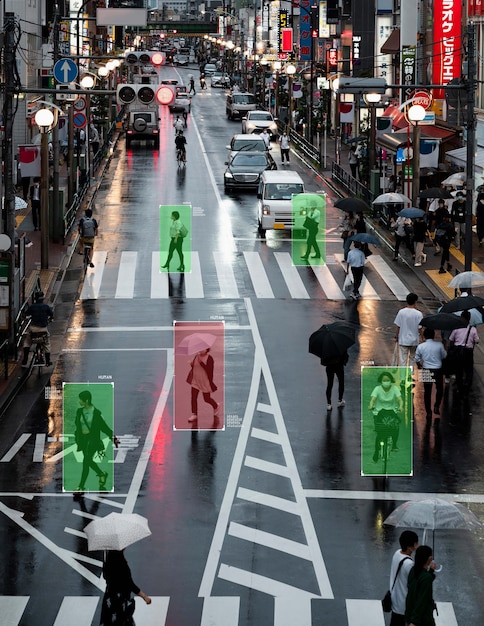DOJ’s New Strategy: Combating Racial Profiling in Law Enforcement

Recent updates from the Department of Justice (DOJ) highlight a renewed focus on combating racial profiling in law enforcement through enhanced training, data collection, and community engagement initiatives aimed at promoting fair and unbiased policing practices across the United States.
The Recent Updates: The Department of Justice’s New Focus on Combating Racial Profiling in Law Enforcement represents a significant shift in how the U.S. government addresses systemic issues within its police forces. This initiative aims to foster trust between law enforcement and the communities they serve, ensuring equal justice for all.
Understanding the DOJ’s Renewed Commitment
The Department of Justice’s (DOJ) recent emphasis on combating racial profiling marks a critical juncture in the pursuit of equal justice under the law. This renewed commitment reflects a growing awareness of the detrimental effects of biased policing and a determined effort to implement systemic changes. These changes aim not only to rectify past injustices but also to build a more equitable foundation for future law enforcement practices.
This initiative encompasses a range of strategies designed to address the root causes of racial profiling. By prioritizing data transparency, community engagement, and enhanced training, the DOJ seeks to foster trust between law enforcement agencies and the communities they serve. The ultimate goal is to ensure that every individual is treated fairly and with respect, regardless of their race or ethnicity.

Key Components of the DOJ’s Strategy
The DOJ’s strategy pivots around several core components, each designed to tackle different facets of racial profiling. These include:
- Enhanced Training Programs: Implementing comprehensive training programs for law enforcement officers to recognize and address implicit biases, cultural sensitivity, and de-escalation techniques.
- Data Collection and Transparency: Improving the collection, analysis, and public reporting of data related to law enforcement interactions, including stops, searches, and arrests, to identify and address potential disparities.
- Community Engagement Initiatives: Fostering open dialogue and collaboration between law enforcement agencies and the communities they serve through town hall meetings, advisory boards, and other engagement strategies.
- Accountability Measures: Strengthening accountability mechanisms to address instances of racial profiling, including internal investigations, disciplinary actions, and civilian oversight boards.
Collectively, these components form a robust framework for combating racial profiling and promoting fair and unbiased policing practices across the United States.
In conclusion, the DOJ’s renewed commitment to fighting racial profiling is characterized by a multi-pronged approach focused on education, transparency, community involvement, and accountability, laying the groundwork for more equitable law enforcement practices nationwide.
Historical Context of Racial Profiling in the US
The issue of racial profiling in the United States is deeply rooted in a long history of discrimination and unequal treatment under the law. Understanding this historical context is essential to grasping the significance of the DOJ’s recent initiatives and the challenges that lie ahead. For decades, racial profiling has been a pervasive issue, disproportionately affecting communities of color and eroding trust in law enforcement.
From the Jim Crow era to contemporary policing practices, racial bias has played a significant role in shaping law enforcement interactions. Discriminatory policies and practices have led to the over-policing of minority communities, resulting in higher rates of stops, searches, and arrests for individuals based on their race or ethnicity.
Landmark Cases and Legal Challenges
Several landmark cases and legal challenges have brought the issue of racial profiling to the forefront of public awareness. These include:
- Terry v. Ohio (1968): This Supreme Court case established the “reasonable suspicion” standard for stop and frisk, which has been criticized for enabling racial profiling.
- United States v. Martinez-Fuerte (1976): This case upheld the legality of immigration checkpoints, leading to concerns about racial profiling of Hispanic individuals.
- Floyd v. City of New York (2013): A federal court ruled that the New York Police Department’s stop-and-frisk practices were unconstitutional and discriminatory against Black and Latino individuals.
These cases highlight the ongoing legal battles to challenge and dismantle racial profiling practices, underscoring the urgent need for systemic reform.
In summary, the historical backdrop of racial profiling in the US includes a legacy of discriminatory practices and landmark legal cases, emphasizing the critical importance of the DOJ’s current initiatives.
The Role of Technology and Data in Addressing Bias
In recent years, technology and data analysis have emerged as powerful tools in the fight against racial profiling. The DOJ is increasingly leveraging these resources to identify patterns of bias, improve accountability, and promote fair and equitable policing practices. By harnessing the power of data-driven insights, law enforcement agencies can gain a deeper understanding of their own practices and implement targeted interventions to address disparities.
Data collection and analysis can help reveal systemic biases that may not be immediately apparent through anecdotal evidence alone. By tracking data on stops, searches, arrests, and use of force, agencies can identify patterns that suggest racial profiling and take steps to rectify them.

Using Data to Drive Change
Here are several ways technology and data are being used to combat racial profiling:
- Body-Worn Cameras: Deploying body-worn cameras to enhance transparency and accountability in law enforcement interactions.
- Data Analytics: Utilizing data analytics to identify and address racial disparities in policing practices.
- Predictive Policing: Implementing algorithms to predict and prevent crime, while carefully monitoring for bias and unintended consequences.
- Community Transparency Portals: Creating online portals to share data and information with the public, fostering trust and collaboration.
While technology offers promising solutions, it is essential to ensure that these tools are used responsibly and ethically, with a focus on fairness, transparency, and accountability.
In essence, integrating technology and data analysis into law enforcement strategies offers a data-driven approach to identifying and rectifying racial biases, thereby fostering greater fairness and accountability.
Community Engagement and Trust-Building
Effective community engagement is paramount to combating racial profiling and fostering trust between law enforcement agencies and the communities they serve. The DOJ recognizes that building strong relationships with local residents is essential to creating a safe and inclusive environment for all. This requires a concerted effort to listen to community concerns, address grievances, and promote transparency and accountability.
Community engagement initiatives can take many forms, including town hall meetings, advisory boards, community policing programs, and youth outreach activities. The goal is to create ongoing dialogue and collaboration, ensuring that law enforcement practices are responsive to the needs and concerns of the community.
Strategies for Meaningful Engagement
To ensure that community engagement is meaningful and impactful, agencies should consider the following strategies:
- Establish Advisory Boards: Create community advisory boards comprised of diverse stakeholders to provide input and guidance on law enforcement policies and practices.
- Conduct Town Hall Meetings: Hold regular town hall meetings to provide opportunities for community members to voice their concerns and ask questions.
- Implement Community Policing Programs: Assign officers to specific neighborhoods to build relationships with residents and address local issues.
- Develop Youth Outreach Activities: Engage with young people through mentoring programs, sports leagues, and other activities to build trust and positive relationships.
By prioritizing community engagement, law enforcement agencies can foster a culture of trust, transparency, and collaboration, reducing the potential for racial profiling and promoting fair and equitable policing practices.
In conclusion, community engagement is a cornerstone of effective policing, fostering trust and collaboration through diverse initiatives and open communication channels.
Challenges and Obstacles in Implementing Reform
Despite the best intentions, implementing meaningful reforms to combat racial profiling in law enforcement is often met with significant challenges and obstacles. These challenges can range from resistance to change within law enforcement agencies to political opposition and resource constraints. Overcoming these obstacles requires a comprehensive and sustained effort, as well as a willingness to adapt and innovate.
One of the most common challenges is resistance to change within law enforcement agencies. Some officers may be reluctant to embrace new training programs or policies, particularly if they perceive them as infringing on their authority or effectiveness. Overcoming this resistance requires strong leadership, clear communication, and a commitment to addressing the concerns of officers.
Navigating Resistance and Bureaucracy
Here are some of the key obstacles to reform:
- Resistance to Change: Overcoming resistance to new training programs and policies within law enforcement agencies.
- Political Opposition: Facing political opposition to reforms from elected officials and advocacy groups.
- Resource Constraints: Addressing funding limitations and staffing shortages that can hinder implementation efforts.
- Lack of Accountability: Strengthening accountability mechanisms to address instances of racial profiling.
Addressing these challenges requires a multi-faceted approach, including strong leadership, effective communication, adequate resources, and a commitment to accountability.
In summary, reform efforts often face hurdles like internal resistance, political headwinds, resource limitations, and accountability gaps, requiring a comprehensive and adaptable approach.
The Future of Combating Racial Profiling
Looking ahead, the future of combating racial profiling in law enforcement will likely involve a continued emphasis on data-driven strategies, community engagement, and technological innovation. The DOJ’s recent initiatives represent a significant step forward, but sustained effort and investment will be required to achieve lasting change. This includes ongoing training for law enforcement officers, improved data collection and analysis, and enhanced community engagement initiatives.
One promising trend is the increasing use of technology to promote transparency and accountability in policing. Body-worn cameras, data analytics, and community transparency portals are all tools that can help to reduce racial profiling and foster trust between law enforcement agencies and the communities they serve.
Emerging Trends and Innovations
Here are some emerging trends and innovations in the fight against racial profiling:
- Artificial Intelligence (AI): Using AI to analyze data and identify patterns of bias in policing practices.
- Virtual Reality (VR) Training: Implementing VR training to simulate real-world scenarios and help officers develop de-escalation techniques.
- Citizen Oversight Boards: Empowering citizen oversight boards to review law enforcement practices and make recommendations for improvement.
- Community-Based Justice Initiatives: Investing in community-based justice initiatives that address the root causes of crime and promote positive relationships between law enforcement and the community.
By embracing these innovative approaches, law enforcement agencies can move closer to the goal of fair and equitable policing for all.
In essence, the future of combating racial profiling lies in integrating data-driven strategies, technological advancements, and community-based approaches towards more equitable law enforcement.
| Key Point | Brief Description |
|---|---|
| 👮 Training | Enhanced law enforcement training to address implicit biases. |
| 📊 Data | Improved data collection and transparency in policing practices. |
| 🤝 Community | Stronger community engagement for trust-building. |
| ⚖️ Accountability | Increased accountability measures for profiling incidents. |
Frequently Asked Questions
▼
Racial profiling is the discriminatory practice by law enforcement officials of targeting individuals for suspicion based on their race, ethnicity, or national origin rather than individualized suspicion.
▼
The DOJ’s increased focus is due to growing concerns about systemic biases in policing and the need to ensure fair and equal treatment for all individuals, regardless of race or ethnicity.
▼
Key components include enhanced training, data collection and transparency, community engagement initiatives, and strengthened accountability measures for law enforcement agencies.
▼
Communities can get involved by participating in town hall meetings, serving on advisory boards, and collaborating with local law enforcement agencies on community policing initiatives.
▼
The long-term goals include reducing racial disparities in policing, fostering trust between law enforcement and communities, and promoting fair and equitable justice for all.
Conclusion
In conclusion, the Department of Justice’s recent emphasis on combating racial profiling in law enforcement represents a pivotal step toward ensuring equal justice and fostering trust between law enforcement and the diverse communities they serve. By prioritizing comprehensive training, transparent data practices, and genuine community engagement, the DOJ aims to address systemic biases and promote fair, equitable policing for all individuals, regardless of their race or ethnicity.





